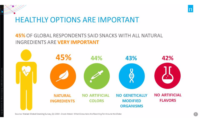
By surveying 40 industry experts, including top manufacturers, market researchers, award-winning chocolatiers, nutritionists and confectionery makers, the National Confectioners Association (NCA) sought to determine what will drive confectionery growth through 2014.
In its recently released Confectionery Industry Trend Report 2009, respondents singled out healthier confections, global flavor influences and eco-friendly manufacturing and marketing practices as the primary stimuli during the next five years.
Nearly 9 of ten (88%) experts believe that the next “big” trend will revolve around healthier confectionery options, specifically a growing demand for health benefits and “better-for-you” ingredients. The advent of portion-control-size treats, complimented by ongoing medical research extolling the potential heart health benefits of higher cacao content to chocolate, continue to have an impact on consumers.
As consumers continue to search out healthy lifestyles, health benefits will heavily influence manufacturers to focus on developing confections that feature all-natural ingredients or functional additives aimed at easing stress, adding energy, improving digestion or providing key vitamins and minerals.
The potential health benefits of the antioxidants found in chocolate will continue to be emphasized to consumers, particularly as positive health-related findings involving chocolate are discovered.
Nearly half of those surveyed say consumers can expect to see more research into the potential health benefits of milk chocolate and dark chocolate, including exploration of naturally occurring cocoa compounds and positive effects on mood and blood pressure levels.
“Chocolate is a classic indulgence,” says Susan Smith, senior vice president of the NCA’s Chocolate Council. “From its potential health benefits to its organic roots and inclusion as an ingredient in many types of sweet and savory foods, we have only begun to experience the versatility of chocolate.”
Confectionery manufacturers also will embrace social responsibility. More than two-thirds of those polled said manufacturers will adopt eco-friendly manufacturing efforts such as recyclable packaging. Energy conservation, equitable ingredient sourcing and good corporate citizenship, both on a local and macro level, will influence product development and consumer purchasing.
Emphasis on Innovation
In 2008 alone, more than 6,000 new confectionery and snack products debuted to meet consumer demand. Candy, chocolate and gum continued to lead the snack category in sales and ranked third in food sales overall. While classic candies remain close to consumers’ hearts, minds and tastes, a maturing American palate is trending toward twists, turns and more innovative product creations.
Experts say limited editions - which allow confectioners the freedom to experiment with flavors in a variety of ways - will continue to prevail. Limited-time product extensions, which typically involve straightforward makeovers of a product, say from milk to dark chocolate, also will remain popular, experts believe. Experimental limited editions will include more entertainment promotional ties and new takes on old favorites involving unconventional flavor combinations.
When it comes to kids’ candies, those polled reinforced the notion that it’s all about intense new flavors and interactive experiences. Respondents comment that this dynamic category is unique and different from all other products in the market, catering to the more attention-grabbing, fun and entertaining products that kids like.
Global Influences
International spices and ethnic flavors will have a large influence on new U.S. products and flavor development overall, more than half (58%) the participants said. While Asian and Latin flavors will serve as the biggest influences on U.S. confectionary product launches, insiders point to Europe as the birthplace for international confectionery trends now and in the years to follow. And although Europe is most frequently perceived as the origin of confectionery trends, Japan does appear to be an emerging influencer in the candy industry.
Forty-three percent of those surveyed said consumers are going to become more open to chocolate and flavor infusions that include spices, salts, herbs and floral flavors. For example, exotic fruit pairings such as mango will become more prominent. And ethnic flavors involving herbs and chocolate will become popular, as will sweet and savory combinations such as chocolate and bacon or chocolate and cheese.
And when it comes to America’s global influence, one in three industry experts say U.S. trends will have the greatest impact on the dark chocolate market. Twenty percent say the U.S. market for confections will influence product pricing and economic issues overseas.
For more information on emerging trends, chocolate and candy statistics and much more, visit www.candyusa.org.





